NCERT Solutions Class 9 Science Chapter 15 Improvement in Food Resources – Here are all the NCERT solutions for Class 9 Science Chapter 15. This solution contains questions, answers, images, step by step explanations of the complete Chapter 15 titled Improvement in Food Resources of Science taught in class 9. If you are a student of class 9 who is using NCERT Textbook to study Science, then you must come across Chapter 15 Improvement in Food Resources. After you have studied lesson, you must be looking for answers of its questions. Here you can get complete NCERT Solutions for Class 9 Science Chapter 15 Improvement in Food Resources in one place. For a better understanding of this chapter, you should also see Chapter 15 Improvement in Food Resources Class 9 notes , Science.
NCERT Solutions For Class 9 Science Chapter 15 Improvement in Food Resources
Topics and Sub Topics in Class 9 Science Chapter 15 Improvement in Food Resources:
- Improvement in Food Resources
- Improvement in Crop Yields
- Animal Husbandry
These solutions are part of NCERT Solutions for Class 9 Science . Here we have given Class 9 NCERT Science Text book Solutions for Chapter 15 Improvement in Food Resources.
In-Text Questions Solved
NCERT Textbook for Class 9 Science – Page 204
Question 1. What do we get from cereals, pulses, fruits and vegetables?
Answer:
Cereals give carbohydrates which provide energy.
Pulses give proteins which build our body.
Vegetables and fruits provide vitamins and minerals.
More Resources for CBSE Class 9
- NCERT Solutions
- NCERT Solutions Class 9 Maths
- NCERT Solutions Class 9 Social Science
- NCERT Solutions Class 9 English
- NCERT Solutions Class 9 Hindi
- NCERT Solutions Class 9 Sanskrit
- NCERT Solutions Class 9 IT
- RD Sharma Class 9 Solutions
Class 9 Science NCERT Textbook – Page 205
Question 1. How do biotic and abiotic factors affect crop production?
Answer:
Factors responsible for loss of grains, during storage and production are:
(a) Biotic factors like rodents, pests, insects, etc.
(b) Abiotic factors like temperature, humidity, moisture, etc.
Combination of both biotic and abiotic factors causes :
- infestation of insects
- weight loss
- poor germination ability
- degradation in quality
- discolouration
- poor market price
Question 2. What are the desirable agronomic characteristics for crop improvements?
Answer:
Desirable agronomic characteristics for crop improvements are:
(a) Tallness and profuse branching are desirable characters for fodder crops.
(b) Dwarfness is desired in cereals, so that less nutrients are consumed by these crops.
Formulae Handbook for Class 9 Maths and Science Educational Loans in India
NCERT Textbook for Class 9 Science – Page 206
Question 1. What are macro-nutrients and why are they called macro-nutrients?
Answer:
Macro-nutrients are the essential elements which are utilised by plants in large quantities. Many macro-nutrients are required by the plants for the following functions:
- As the constituent of protoplasm
- N, P, S are present in proteins
- Ca is present in cell wall
- Mg is important constituent of chlorophyll
Question 2. How do plants get nutrients?
Answer:
Plants get nutrients from air, water and soil. There are, sixteen nutrients essential for the growth of plants. Carbon and Oxygen are supplied by water. The remaining thirteen nutrients are supplied by soil.
Class 9 Science NCERT Textbook – Page 207
Question 1. Compare the use of manure and fertilizers in maintaining soil fertility.
Answer: Effects of using manures on soil quality:
- The manures enrich the soil with nutrients.
- They provide a lot of organic matter (humus) to the soil and thus restores water retention capacity of sandy soils and drainage in clayey soil.
- The addition of manures reduces soil erosion.
- They provide food for soil organisms, like soil friendly bacteria.
Effects of using fertilizers on soil quality:
- By the continuous use of fertilizers, the soil becomes powdery, dry and rate of soil erosion increases.
- By the use of fertilizers, the organic matter decreases which further decreases the porosity of soil and the plant roots do not get oxygen properly,
- The nature of soil changes to acidic or basic.
NCERT Textbook for Class 9 Science – Page 208
Question 1. Which of the following conditions will give the most benefits? Why?
(a) Farmers use high-quality seeds, do not adopt irrigation or use fertilizers.
(b) Farmers use ordinary seeds, adopt irrigation and use fertilizer.
(c) Farmers use quality seeds, adopt irrigation, use fertilizer and use crop protection measures.
Answer:
In this, (c) Farmers use quality seeds, adopt irrigation, use fertilizer and use crop protection measures.
Use of any quality seeds is not sufficient until they are properly irrigated, enriched with fertilizers and protected from biotic factors. Hence, option (c) will give the most benefits.
Class 9 Science NCERT Textbook – Page 209
Question.1. Why should preventive measures and biological control methods be preferred for protecting crops?
Answer.
Diseases in plants are caused by pathogens. To get rid of pathogens, some preventive measures and biological control methods are used as they are simple, economic and minimise pollution without affecting the soil quality.
Question 2. What factors may be responsible for losses of grains during storage?
Answer:
The factors responsible for losses of grains during storage are:
- Abiotic factors like moisture (present in food grains), humidity (of air) and temperature.
- Biotic factors like insects, rodents, birds, mites, bacteria and fungi.
NCERT Textbook for Class 9 Science – Page 210
Question 1. Which method is commonly used for improving cattle breeds and why ?
Answer:
Cross breeding is a process in which indigenous varities of cattle are crossed by exotic breeds to get a breed which is high yielding. During cross breeding, the desired characters are taken into consideration. The offspring should be high yielding, should have early maturity and should be resistant to climatic conditions.
Class 9 Science NCERT Textbook – Page 211
Question 1. Discuss the implications of the following statement:
“It is interesting to note that poultry is India’s most efficient converter of low fibre food stuff (which is unfit for human consumption) into highly nutritious animal protein food”.
Answer:
The basic aim of poultry farming is to raise domestic fowl for egg production and chicken meat. These poultry birds are not only the efficient converters of agricultural by-products, particularly cheaper fibrous wastes (which is unfit for human consumption but can be formulated into cheaper diets for poultry birds) into high quality meat and also help in providing egg, feathers and nutrient rich manure. For this reasons, it is said that, “poultry is India’s most efficient converter of low fibre food stuff into highly nutritious animal protein food”.
NCERT Textbook for Class 9 Science – Page 211
Question 1. What management practices are common in dairy and poultry farming?
Answer:
- Shelter: Dairy animals and poultry birds require proper shelter, i.e., well designed dairy and hygienic shelter.
- Feeding: To get good yield of food product, proper feed is provided to dairy animals and poultry birds.
- Caring for animal health: Animal and birds must be protected from diseases caused by virus, bacteria or fungi.
Question 2. What are the differences between broilers and layers and in their management?
Answer:
The poultry bird groomed for obtaining meat is called broiler. The egg laying poultry bird is called layer.
The housing, nutritional and environmental requirements of broilers are somewhat different from those of egg layers.
The ration (daily food requirement) for broilers is protein rich with adequate fat. The level of vitamins A and K is kept high in the poultry feeds while layers require enough space and proper lightning.
Class 9 Science NCERT Textbook – Page 213
Question 1. How are fish obtained?
Answer:
There are two ways of obtaining fish. One is from natural resources, which is called capture fishing. The other way is by fish farming, which is called culture fishery.
Question 2. What are the advantages of composite fish culture?
Answer:
In composite fish culture, a combination of five or six fish species is used in a single fish pond. These species are selected so that they do not compete for food among them and are having different types of food habits. As a result, the food available in all the parts of the pond is used. For example, Catlas are surface feeders, Rohus feed in the middle-zone of the pond, Mrigals and Common Carps are bottom feeders and Grass Carps feed on the weeds, together these species can use all the food in the pond without competing with each other. This increases the fish yield from pond.
NCERT Textbook for Class 9 Science – Page 213
Question 1. What are the desirable characters of bee varieties suitable for honey production?
Answer:
- The variety of bee should be able to collect a large amount of honey.
- The bees should stay in a given beehive for a longer period.
- The bees should have capacity of breeding well.
- The variety of bee should be disease resistant.
Question 2. What is pasturage and how is it related to honey production?
Answer:
The pasturage means the flowers available to the bees for nectar and pollen collection. In addition to adequate quantities of pasturage, the kind of flowers available will determine the taste of the honey.
Questions From NCERT Textbook for Class 9 Science
Question 1. Explain any one method of crop production which ensures high yield.
Answer:
One method used for crop production which ensures high yield is plant breeding. It is the science involved in improving the varieties of crops by breeding plants. The plants from different areas/places is picked up with desired traits and then hybridisation or cross-breeding of these varieties is done to obtain a plant/crop of desired characteristic.
The high yielding crop variety shows the following characteristics:
High yield, early maturation, less water for irrigation, better quality seeds are produced, less fertilizers required, adapts itself to the environmental conditions.
Question 2. Why are manure and fertilizers used in fields?
Answer:
They are used to ensure good vegetative growth (leaves, branches and flowers), giving rise to healthy plants, that results in high crop production.
Question 3. What are the advantages of inter-cropping and crop rotation?
Answer:
Advantages of using inter-cropping:
- It helps to maintain soil fertility.
- It increases productivity per unit area.
- Save labour and time.
- Both crops can be easily harvested and processed separately.
Advantages of using crop rotation:
- It improves the soil fertility.
- It avoids depletion of a particular nutrient from soil.
- It minimise pest infestation and diseases.
- It helps in weed control.
- It prevents change in the chemical nature of the soil.
Question 4. What is genetic manipulation? How is it useful in agricultural practices?
Answer:
Genetic manipulation is a process of incorporating desirable (genes) characters into crop varieties by hybridisation. Hybridisation involves crossing between genetically dissimilar plants. This is done for production of varieties with desirable characteristics like profuse branching in fodder crops, high yielding varieties in maize, wheat, etc.
Genetic manipulation is useful in developing varieties which shows:
- Increased yield
- Better quality
- Shorter and early maturity period
- Better adaptability to adverse environmental conditions
- Desirable characteristics
Question 5. How do storage grain losses occur?
Answer:
The factors responsible for loss of grains during storage are:
- Abiotic factors like moisture (present in foodgrains), humidity (of air) and temperature.
- Biotic factors like insects, rodents, birds, mites and bacteria.
Question 6. How do good animal husbandry practices benefit farmers?
Answer:
Good animal husbandry practices are beneficial to the farmers in the following ways:
- Improvement of breeds of the domesticated animals.
- Increasing the yield of foodstuffs such as milk, eggs and meat.
-
Proper management of domestic animals in terms of shelter, feeding, care and protection against diseases.
Which ultimately helps the farmers to improve their economic condition.
Question 7. What are the benefits of cattle farming?
Answer:
Cattle farming is beneficial in the following ways:
- Milk production is increased by high yielding animals.
- Good quality of meat, fibre and skin can be obtained.
- Good breed of draught animals can be obtained.
Question 8. For increasing production, what is common in poultry, fisheries and bee-keeping?
Answer:
Through cross breeding, the production of poultry, fisheries and bee-keeping can be increased.
Question 9. How do you differentiate between capture fishing, mariculture, and aquaculture?
Answer:
Capture fishing:
It is the fishing in which fishes are captured from natural resources like pond, sea water and estuaries.
Mariculture:
It is the culture of fish in marine water. Varieties like prawns, oysters, bhetki and mullets are cultured for fishing.
Aquaculture:
It is done both in fresh water and in marine water.
NCERT Solutions for Class 9 Science Chapter 15 Improvement in Food Resources (Hindi Medium)
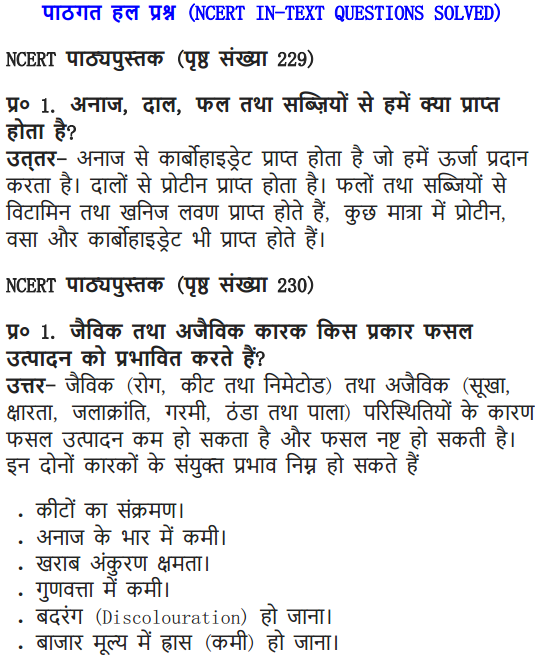
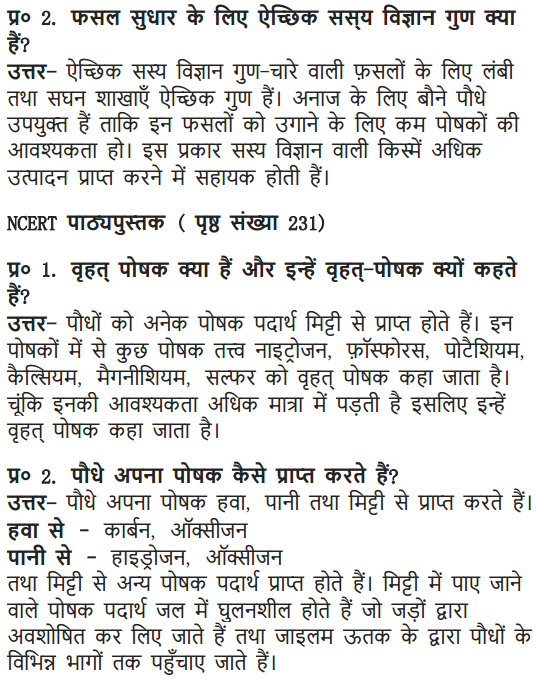
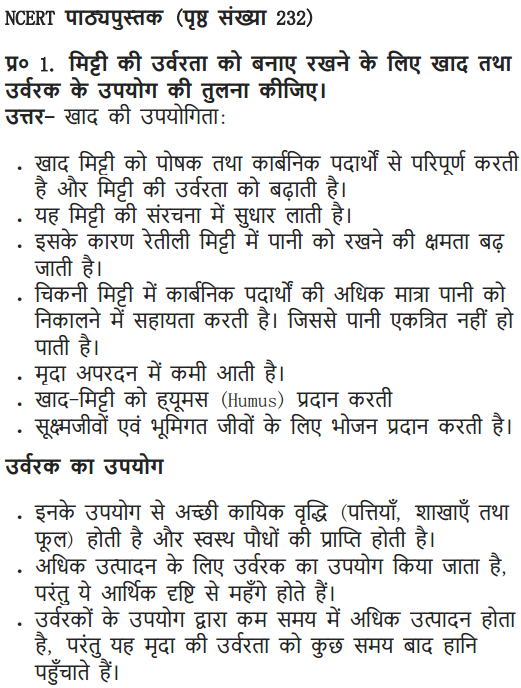
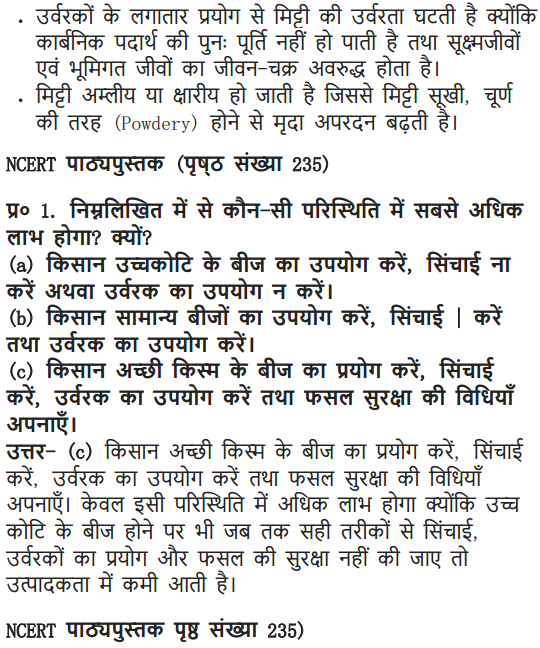
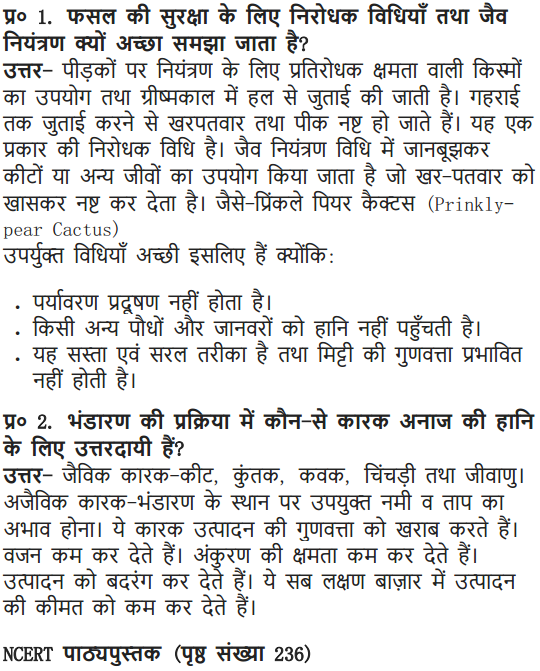
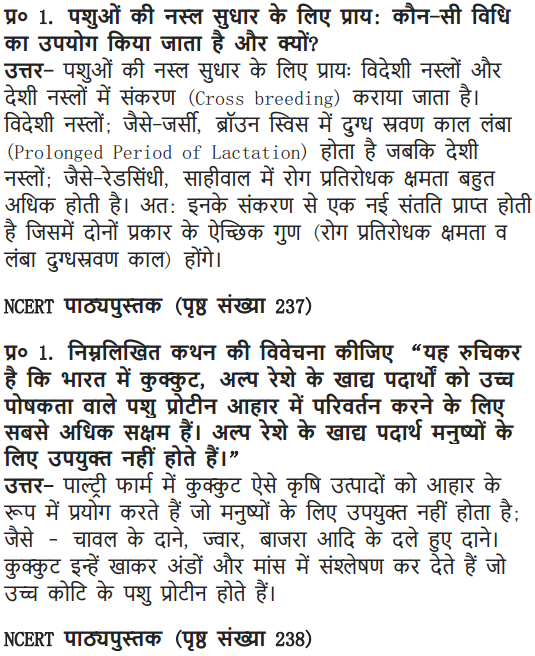
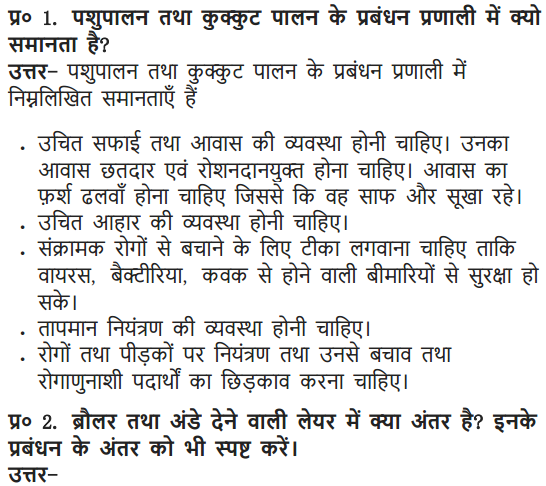
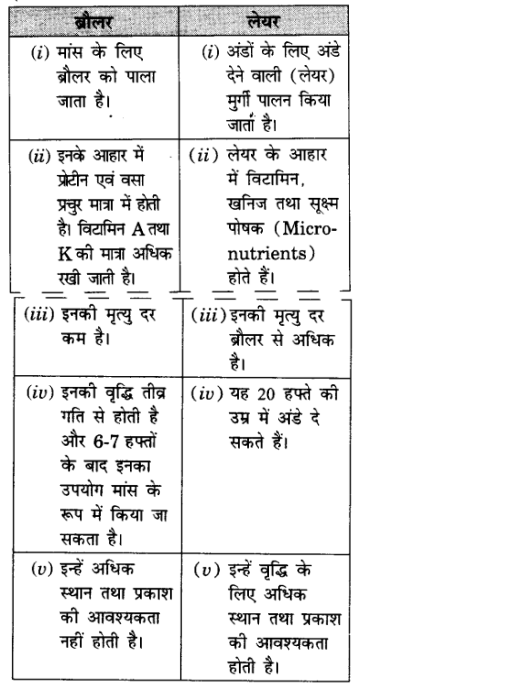
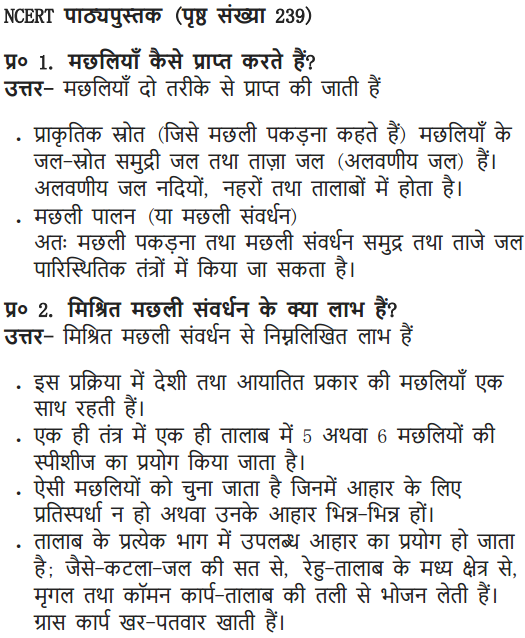
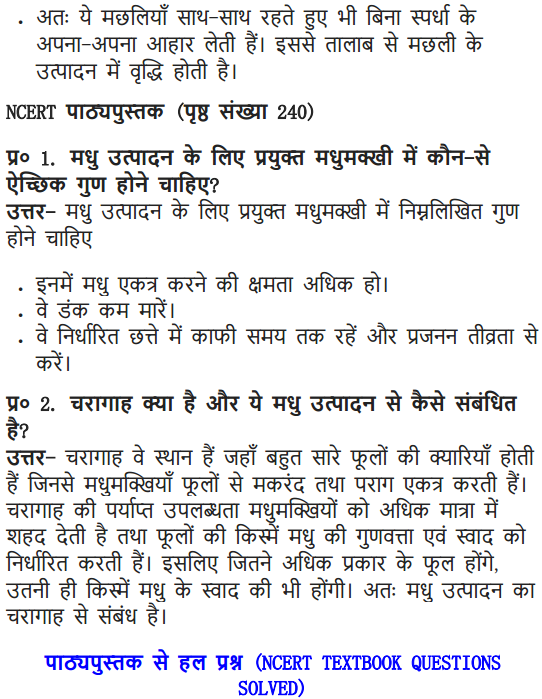
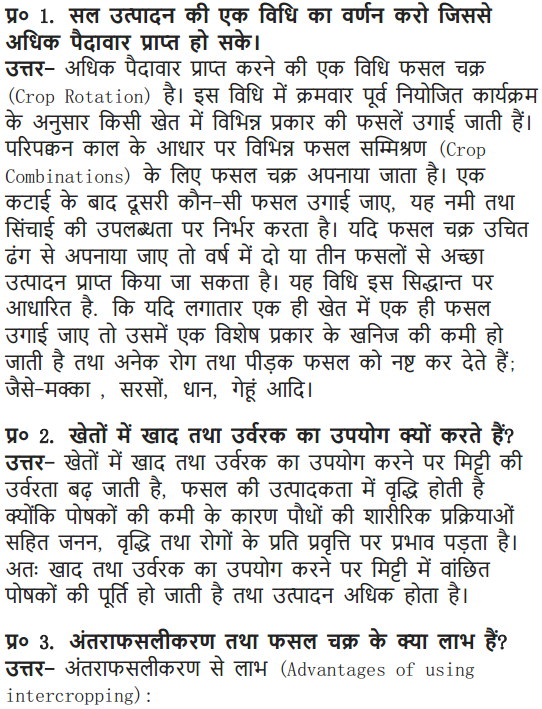
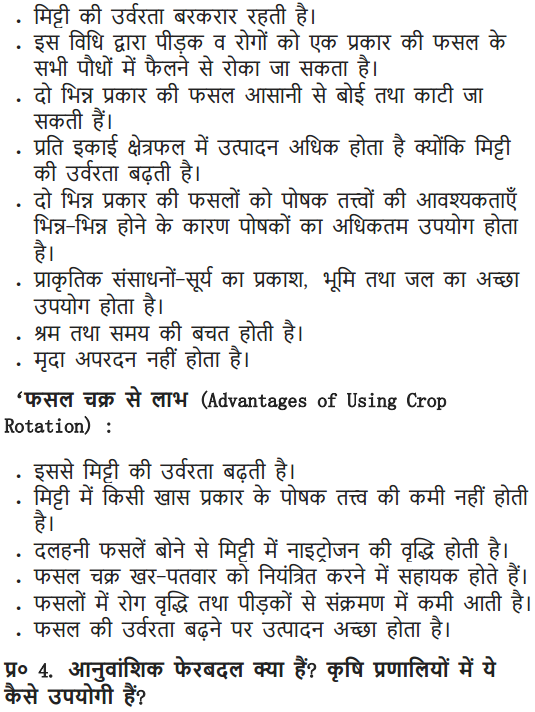
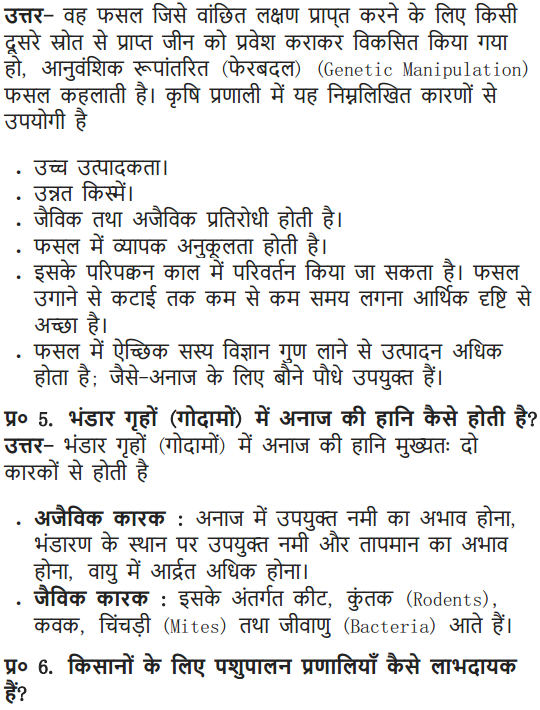
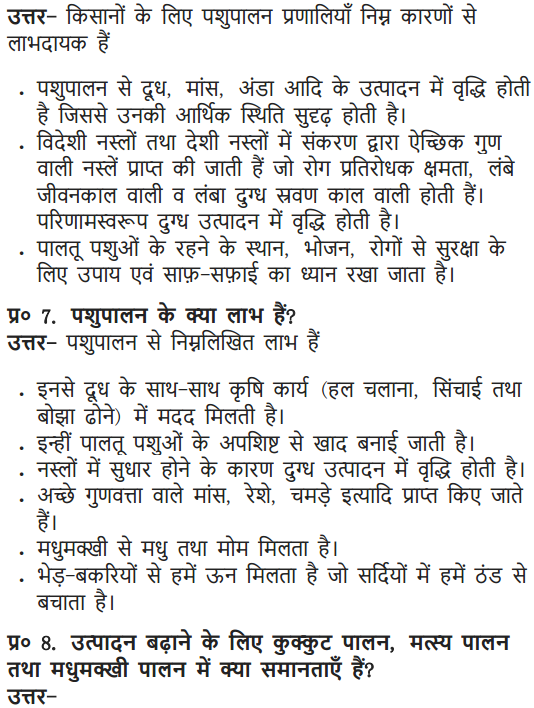
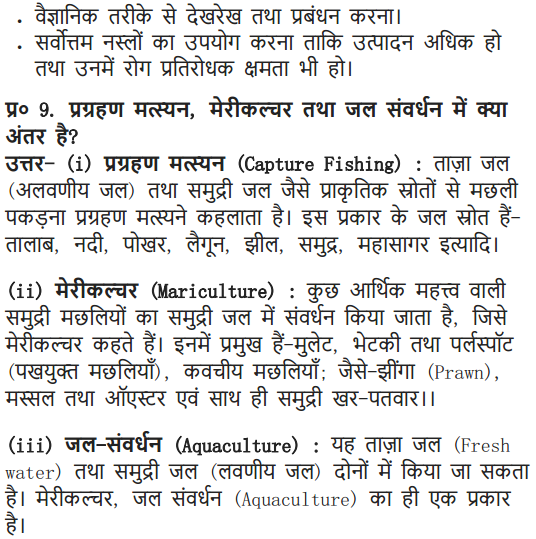
More Questions Solved
NCERT Solutions For Class 9 Science Chapter 15 Multiple Choice Questions
Choose the correct option:
1. The use of fertilizers in farming is an example of
(a) No cost production (b) Low-cost production
(c) High-cost production (d) None of these
2. Nitrogen, phosphorus, potassium are examples of
(a) micro-nutrients (b) macro-nutrients
(c) fertilizer (d) both (ct) and (b)
3. Xanthium, Parthenium, Cyperinus are the examples of
(a) diseases (b) pesticides
(c) weeds (d) pathogens
4. Mullets, bhetki, pearl spots, prawns, mussels are the example of
(a) marine fishes (b) fresh-water fishes
(c) finned fishes (d) shell fish
5. Apis cerana indica is commonly known as
(a) Indian cow (b) Indian buffalo
(c) Indian bee (d) None of these
6. The production and management of fish is called
(a)pisciculture (b) apiculture
(c) sericulture(d) aquaculture
7. Catla and Rohu are examples of
(a) freshwater fish (b) marine water fish
(c) both (a) and (b)(d) none of these
8. Pasturage is related to
(a) cattle (b) fishery
(c) apiculture (d) poultry
9. Growing two oronore crops in definite patterns is known as
(a) crop rotation (b) inter-cropping
(d) organic cropping(c) mixed cropping
10. Leghorn and Aseel are related to
(a) apiculture (b) dairy farming
(c) pisciculture (d) poultry
Answer: 1—(c), 2—(b), 3—(c), 4—(a), 5—(c), 6-(a), 7-(a), 8—(c), 9—(b), 10—(d).
NCERT Solutions For Class 9 Science Chapter 15 Very Short Answer Type Questions
Question 1. Name any two fodder crops.
Answer:
Berseem, oats or sudan grass are raised as food for the livestock, called fodder crops.
Question 2. What do you understand b.y photoperiod of sunlight?
Answer:
Photoperiod are related to the duration of sunlight required for plant growth.
Question 3. Name two kharif crops.
Answer:
Paddy and soyabean.
Question 4. Name two rabi crops.
Answer:
Wheat and gram.
Question 5. Define hybridisation.
Answer:
Hybridisation refers to crossing between genetically dissimilar plants, to obtain, better variety of crops.
Question 6. What are genetically modified crops?
Answer:
By introducing a gene with required characters into a crop for its improvement is called genetically modified crop.
Question 7. “Shorter the duration of the crop from sowing to harvesting, the more economical is the variety”. Give reason for this.
Answer:
Due to short duration of crop growth, farmers can grow more crops in a year, and reduce the cost of drop production.
Question 8. Name different types of crop production practices involved in India.
Answer:
They are (a) no cost production, (b) low cost production and (c) high cost production.
Question 9. Who provides nutrients to plants?
Answer:
Nutrients to plants are provided by air, water and soil.
Question 10. What are macro-nutrients?
Answer:
The nutrients required by plants in larger quantity is called macro-nutrients. They are nitrogen, phosphorus, potassium, calcium, magnesium and sulphur.
Question 11. Name the nutrients that plant obtain from air and water.
Answer:
Air – Carbon and oxygen Water- Hydrogen and oxygen
Question 12. State the difference between compost and vermi-compost.
Answer:
The compost is obtained by decomposition of organic waste like animal excreta, plant waste etc. naturally due to decomposition by bacteria.
Vermi-compost: To hasten the process of decomposition redworms are added to this organic matter to obtain compost.
Question 13. Name any two weeds.
Answer:
Parthenium and Xanthium.
Question 14. What causes disease in plants?
Answer:
It is caused by pathogens such as bacteria, fungi and viruses.
Question 15. Name two Indian cattle.
Answer:
Bos indicus – cows 4 Bos bubalis – buffaloes
Question 16. Name two exotic breeds of cattle.
Answer:
Jersey and Brown Swiss
Question 17. Name two variety of food required for milch animals.
Answer:
- Maintenance requirement – food required to keep animal healthy
- Milk producing requirement – food required for increased lactation Animal food includes roughage and concentrate also.
Question 18. State the meaning of capture fishing and culture fishing.
Answer:
Capture fishing: It is done from natural resources.
Culture fishing: It is done by fish farming.
Question 19. Name four marine fish varieties.
Answer:
Pomphret, mackerel, tuna and sardines.
Question 20. What is apiculture?
Answer:
Keeping bee for obtaining honey commercially is called apiculture.
Question 21. Name the products obtained from apiculture.
Answer:
Honey and wax both are obtained from apiculture.
NCERT Solutions For Class 9 Science Chapter 15 Short Answer Type Questions
Question 1. What are the major group of activities involved for improvement of crop yields?
Answer:
- Crop variety improvement
- Crop production improvement
- Crop protection improvement
Question 2. What are the different ways/ methods of hybridisation?
Answer:
Hybridisation can be
- Intervarietal – between different varieties of crops
- Interspecific – between two species of same genus
- Intergeneric – between two different genera
Question 3. What are the main characters required in a crop during its improvement practices?
Answer:
The useful characters that are required in a crop during its improvement:
(a) Disease resistance (b) Response to fertilizer
(c) Product quality and (d) High yield.
Question 4. State the difference between macro-nutrients and micro-nutrients.
Answer:

Question 5. How do deficiency of nutrients affect the crop?
Answer:
Deficiency of any nutrient affects physiological processes in plants including reproduction, growth and susceptibility to diseases.
Question 6. State the difference between manure and fertilizer.
Answer:

Question 7. What are the harmful effects of fertilizer? .
Answer.
It causes soil and water pollution. Continuous use can also destroy soil fertility.
Question 8. What is organic farming?
Answer:
It is the farming in which no chemical fertilizers, pesticides or herbicides are used. But uses all organic matter for its growth like manure, neem leaves as pesticides and for grain storage.
Question 9. State the preventive and control measures used before grains are stored.
Answer:
- Cleaning of the grains
- Proper drying of the produce in sunlight, there should be no moisture.
- Fumigation of produce using chemicals that kills pest.
Question 10. Name few varieties of bees used for commercial honey production.
Answer:
Apis cerana indica – Indian bee
A. dorsata – rock bee (local varieties)
A. florae – the little bee
A. mellifera – Italian bee variety
Question 11. What decide the quantity and quality of honey production in apiary?
Answer:
For quality of honey: The pasturage, f.e., the kind of flowers available to the bees for nectar and pollen collection will determine the taste of the honey. For quantity of honey: Variety of bee used for the collection of honey. For example, A. mellifera is used to increase yield of honey.
Question 12. How are crops useful to us? What do they provide?
Answer:
Crops provide us food for our daily body nutrient. Carbohydrate for energy
requirement – Cereals such as wheat, rice, maize.
Protein for body building — Pulses like gram, lentil
Fats for energy — Oil seed like mustard, sunflower
Vitamins and minerals — From vegetables, spices and fruits
Fodder crops — For livestocks
Question 13. What are the factors for which variety improvement of crop is done?
Answer:
(a) Higher yield:
It increases production of crop.
(b) Biotic and abiotic resistance:
Crop should be resistant to biotic factors
like diseases, insects, pests and abiotic factor like drought, salinity, heat, cold, frost and water logging.
(c) Change in maturity duration:
Short-duration maturity allows farmer to grow more crops in a year and reduces the cost of crop production.
(d) Wider adaptability:
Crop’should be able to adapt to changing environmental conditions.
(e) Desirable agronomic characteristics:
The tallness and dwarfness of crop. Dwarfness is required for cereals, so that less nutrients are consumed.
Question 14. Name the sources and the nutrients supplied by them to the plants.
Answer:
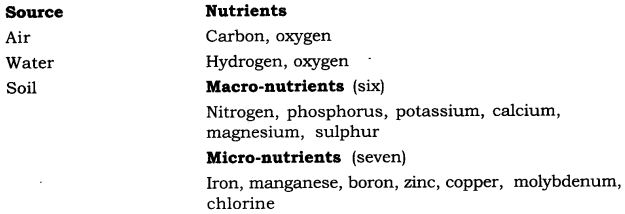
Question 15. What are manures? Give its classification.
Answer:
Manures contain large ‘ quantities of organic matter and supplies small quantities of nutrients to the soil. It is prepared naturally by the decomposition of animal waste, excreta and plant waste.
- It helps in the soil enrichment with nutrients.
- It helps in improving the soil structure.
- It helps in increasing the water holding capacity in sandy soils.
-
In clayey soils it helps in the water drainage and prevent water logging. Manure is classified based on the kind of biological material used to make it as : (i) Compost (ii) Vermi-compost (iitj Green manure
(i) Compost: The farm waste and livestock excreta, along with vegetable waste, sewage waste, weeds, straws etc. are allowed to decompose in a pit is called compost. The compost is rich in nutrients.
(ii) Vermi-compost: When the above given matter is allowed to decompose in the pit along with some earthworms, the decomposition speeds up and is called vermi-composting.
(iii) Green manure: Some plants like sun-hemp or guar are grown and then mulched by ploughing them into the soil. This is done before the sowing of crop seeds into the field.
These green plants present in the soil acts as green manure which enriches the soil in nitrogen and phosphorus.
Question 16. What are fertilizers? Excess use of fertilizers is not advisable, explain?
Answer:
Fertilizers are obtained artificially on commercial basis. It is a chemical which contains the nutrients required for the crop to grow. Fertilizers supply various nutrients as they are nutrient specific e.g.-urea provides nitrogen. Mixed fertilizer provides any two mixture of nutrients. They are expensive but their use yield large production hence are a factor of high cost farming.
Excessive use of fertilizers are not advisable as:
(a) It leads to soil and water pollution.
(b) It can destroy the fertility of soil. As the soil is not replenished, micro¬organisms in the soil are harmed by fertilizers.
Question 17. What are the different patterns of cropping?
Or
What are the different cropping systems?
Answer:
Different ways/patterns / systems of growing crop’s are:
(a) Mixed cropping (b) Inter-cropping (c) Crop rotation.
Mixed cropping:
It is a method in which two or more crops grow simultaneously on the same piece of land.
Example, Wheat + grain, wheat + mustard or groundnut + sunflower.
This helps in the reduction of risk factor and provides insurance against failure of one of the crops.
Inter-cropping:
It is a method of growing two or more crops simultaneously on the same field in a definite patterns. A few row of one crop alternate with a few rows of second crop.
Example, soyabean + maize or bajra + lobia
Crop rotation:
The growing of different crops on a piece of land in a pre¬planned succession is known as crop rotation.
The availability of moisture and irrigation facility decides the choice of crop to be cultivated after one harvest.
Question 18. How does insect pests attack the plant and affect it?
Answer:
Insect pests attack the plants in three ways:
- They cut the root, stem and leaf.
- They suck the cell sap from various parts of the plant.
- They bore into stem and fruits.
This way they affect the health of the crop and reduces yield.
Question 19. Give different methods of weed control.
Answer:
Weeds can be controlled by different methods:
(a) Weedicides:
These are the chemicals sprayed on the weeds to kill them. Excessive use is poisonous and causes environmental pollution.
(b) Mechanical removal:
In this method weeds are uprooted by removing manually or by machines.
(c) Preventive methods:
Proper seed bed preparation, timely sowing of crops, intercropping and crop rotation helps in weed control.
Question 20. What are the new variety/traits obtained by cross breeding of Indian and exotic breeds of poultry?
Answer:
The new variety/traits obtained by cross breeding of Indian and exotic breeds of poultry are:
- Number and quality of chicks
- Dwarf broiler parent for commercial chick production
- Summer adaptation capacity/tolerance to high temperature
- Low maintenance requirements
- Reduction in the size of the egg-laying bird with ability to utilise more fibrous and cheaper diet, formulated using agricultural by-products
Question 21. State the difference between egg-layers and broiler.
Answer:

NCERT Solutions For Class 9 Science Chapter 15 Long Answer Type Questions
Question 1. What are the various methods of irrigation in India?
Answer:
Most of agriculture in India is rain-fed, several different kinds of irrigation system are adopted to supply water to agricultural lands. The resources are- wells, canals, rivers and tanks.
- Wells: Dug wells and tube wells. In dug wells water is collected from water— bearing strata.
- Tubewells: Can tap water from deeper strata.
- Canals: Most extensive irrigation system. Canals receive water from reservoirs or rivers. The main canal is divided into branch canals having further distributaries to irrigate fields.
- River lift system: Water is directly drawn from the river for supplementing irrigation in areas close to rivers.
- Tanks: These are small storage reservoirs, which intercept and store the run-off of smaller catchment areas.
Question 2. Large amount of food grains get spoiled every year in India due to improper storage of food grains. How can this be avoided?
Answer:
Food grains get spoiled by insects, fungi, rodents, bacteria, moisture, temperature in the place of storage.
Storage losses can be minimised by following preventive and control measures.
- The seeds/grains that are to be stored should be dry, with no moisture in it.
- The grains should be cleaned.
- The grains should be fumigated using chemicals that kills pest.
- The storage houses should be water proof.
- The grains should be stored in sealed gunny bags or metal containers,
- The bags should be stacked in order i.e. in pile for proper fumigation, and should be kept few centimetres away from the wall.
- The ventilators if any should be closed tightly, to avoid birds visiting the storage house and destroying the grains.
- The walls and the floor should be water-proof with no holes in it, to avoid rodents, pests.
Question 3. Explain different types of fisheries.
Answer:
The different types of fisheries are marine fisheries, inland fisheries, capture fishing, mariculture and aquaculture.
- Marine fisheries: Marine fishes are caught using fishing nets. Large schools of fishes is located by satellites. Some are farmed in sea water.
- Mariculture: Marine fishes are cultured in seawater this culture of fisheries is called mariculture.
- Inland fisheries : The fisheries done in fresh water resources like canals, ponds, reservoirs and rivers is called inland fisheries.
- Capture fishing: It is done in sea-water, estuaries and lagoons.
- Aquaculture: Culture of fish done in different water bodies is called aquaculture.
Question 4. What are the practices used for dairy industry?
Answer:
The practices required for raising daily animals to get the optimum yield are:
(i) Shelter, (ii) feeding, (iii) rearing of animals, (iv) breeding.
(i) Shelter:
The shelter should be clean, spacious and airy.
(ii) Feeding:
Proper food is essential for dairy animals, two types of food are roughage and concentrates. Proper feed at proper time is required for dairy animals.
(iii) Rearing of animals:
Providing them proper health care and protection from pathogens, diseases and proper vaccination.
(iv) Breeding:
The crossing of different variety of milch animals to obtain a breed that can produce more yield of milk.
NCERT Solutions For Class 9 Science Chapter 15 Value-Based Questions
Question 1. A group of Eco Club students made a compost pit in the school, they collected all bio-degradable waste from the school canteen and used it to prepare the compost.
(a) Name two waste that can be used for the compost and two wastes obtained from canteen which cannot be used for the compost making?
(b) What is the other important component required for making the compost?
(c) What values of Eco Club students are reflected in this act?
Answer:
(a) Two waste used for compost are vegetable peels and fruit peels. Two waste material that cannot be used as compost are polythene bags and plastic items.
(b) Bacteria and fungi present in soil are the other important component for making compost.
(c) Eco Club students reflect the value of group work, responsible citizens.
Question 2. Surjeet read an article in the newspaper that prolonged and excess use of pesticides and fertilizers leads to cancer in human beings. He also saw the increased number of cancer patients in his town. He started educating the farmers in his town to minimize or stop the use of chemicals in farming and adopt the organic farming.
(a) What is the most common pesticide used in our country?
(b) Give one difference in organic farming and chemical farming.
(c) What value of Surjeet is seen in the above act?
Answer:
(a) The common pesticide is DDT.
(b)
Organic farming:
It is a farming system with minimal or no use of chemicals as fertilizers, herbicides, pesticides etc.
Chemical farming:
Generally, chemicals are used as fertilizers, herbicides, pesticides etc. to increase crop yield.
(c) Surjeet showed the value of responsible person, leadership quality, initiative taker and a concerned citizen
Question 3. Large number of Bhetki fish died and got crushed in the turbines of hydroelectric power stations while they migrated from river to sea. The environmentalist gave power plant the solution to this problem. Now all Bhetki fish is removed with the help of special technique and hence do not enter the turbines to crush and die.
(a) What is pisciculture?
(b) Suggest two different varieties of fish.
(c) What value of environmentalist is reflected in the above case?
Answer:
(a) The rearing of fish on large scale is called pisciculture.
(b) Two varieties of fish are bony and cartilaginous.
(c) Environmentalist showed the value of concerned and caring individuals.
Question 4. A group of gardening club students prepared a kitchen garden in the school campus and did organic farming to grow the vegetables. Then the students presented their group work in the assembly to spread the awareness and make students understand the importance of organic products.
(a) What is horticulture?
(b) What is green manure?
(c) State the values of gardening club students.
Answer:
(a) Production of vegetables and fruits commercially is called horticulture.
(b) The green plants like guar or sun hemp are turned into the soil which enriches the soil with nitrogen and phosphorus and is called green manure.
(c) Values of gardening club students are aware individuals and responsible behaviour.